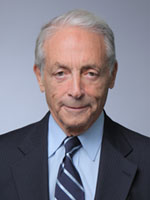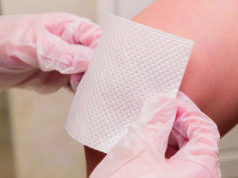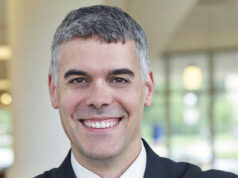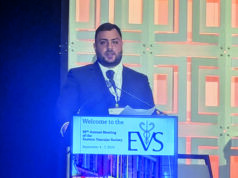
This advertorial is sponsored by AOTI.
In the beginning, it took a little convincing for Anil Hingorani, MD, to come around to the idea that cyclical Topical Wound Oxygen Therapy (TWO2) could be the sort of device he would add to his armamentarium with some degree of confidence. But then he saw the results in some of his most intractable patients, and he started to see value in the multi-modal approach to wound healing.

“Remarkable,” was how the clinical professor of vascular surgery in the Department of Surgery at NYU Grossman School of Medicine in New York described the progress in some of the wounds he treated with TWO2.
“We tried hyperbaric oxygen for a while and found that to be helpful in certain patients, but hyperbaric oxygen was expensive,” explains Hingorani, also describing issues around insurance company authorization difficulties, transportation convenience and potential systemic complications. Home oxygen therapy, on the other hand, “circumvented a lot of those problems,” he said. “We started using TWO2 on our patients who were some of the most difficult—the nonhealing on whom we’d tried everything,” Hingorani continues, describing how the technology was put to use among a demographic of his patients in south Brooklyn who are challenging both economically and in terms of their level of basic medical education.
“Finally, we said, ‘Let’s try this new product.’ We didn’t know if it was going to work, but we had some patients who had had ulcers for years, and other practitioners had tried to take care of these patients. Then we had some positive results. And we started to notice a consistent pattern. That’s why we started using this TWO2 device. Based upon the fact we had some experience with arterial patients, now we’re using this new product with both arterial and venous patients—on diabetic foot ulcers [DFUs]—and we’ve had some very good responses.”
TWO2 combines supplemental oxygen with non-contact cyclical compression and humidification through a single-use extremity chamber system, which is accompanied by a controller and oxygen source.
“For me, what really drives TWO2 is that the machine itself is a little bit different from prior generations in that it not only applies some relatively low oxygen, but also the pressure it puts on is fairly low,” observed Hingorani. The extremity chamber, or boot, extends up to and above the knee, he says, and can be placed over all but occlusive dressings.”
A multinational randomized, double-blinded, placebo-controlled trial to evaluate the efficacy of TWO2 in the treatment of chronic DFUs (known as the TWO2 Study), led by podiatric surgeon Robert G. Frykberg, DPM, and colleagues, showed that the system was six times as likely to heal a DFU wound at 12 weeks compared to optimal standard of care alone after adjusting for ulcer severity (p=0.004). The data, published in the peer-reviewed journal Diabetes Care, demonstrated that TWO2 therapy was “safe, without complications, and provided more durable healing for those who had wound closure compared to optimal standard care alone,” the trial investigators concluded. Additionally, they reported, TWO2 can be “administered by the patient at home without the expense and difficulties of daily travel to a specialized center” and can be combined with other advanced wound care modalities.
Hingorani believes such data—allied to upcoming randomized prospective data being collected for publication in the vascular surgery literature—might help to trigger more widespread uptake of the device.
“TWO2 has shown not only positive wound healing at 12 weeks for DFUs, but also sustained wound healing, especially in patients with DFUs,” he says. “The retrospective data from Ireland for venous stasis ulcers has also shown benefit at 12 weeks for those patients using the product.”

The system “is not meant to replace what you are already doing,” emphasizes Hingorani. Rather, the cyclical pressure—applied twice per minute with oxygen—”makes a big difference in some of our patients” owing to how that component helps combat edema in the wound, which is, “I think, an underappreciated cause for some of our wounds not to heal,” he adds.
Richard Neville, MD, chairman in the Department of Surgery and associate director of Inova Heart and Vascular Institute in Falls Church, Virginia, recently sat in on a presentation on TWO2, leaving with a resolve to dig deeper on the positive impression the technology made on him. “I was impressed by this particular technology more than some of the other ones I’ve heard, and I’m hoping that we can investigate it and that it has a role in our system,” he says.
A wound care expert colleague, Vickie R. Driver, DPM, is keen to pursue research on its efficacy, Neville explains. “The right people think highly of it, so we’re going to look to either investigate—or start to use—the technology, and then hopefully we’ll be able to make some presentations in the vascular space.”
While his hospital system has four hyperbaric oxygen chambers, Neville adds, “this seems different. This is more of a focused raising of oxygen tension in the tissue, which theoretically leads to some advantages that the hyperbaric chamber may not.

Meanwhile, vascular surgery luminary Frank J. Veith, MD, a limb salvage pioneer for more than half a century, says preliminary data behind TWO2 suggest it may hold some promise. He highlighted the device’s advantage of oxygen application in combination with compression and moisture versus hyperbaric oxygen therapy, describing the early findings on the tri-modality approach as a potential indicator that it could prove to be an important adjunct to revascularization. “The data that I’ve seen, although not conclusive indicates that TWO2 could prove to be an adjunct to help save limbs that might not otherwise be saved,” says the New York University and Cleveland Clinic professor of surgery, and former Society for Vascular Surgery (SVS) president. “The technology is not going to replace revascularization, but every little bit helps.”
For Hingorani, one other component stands out: the people behind the equipment at Advanced Oxygen Therapy Incorporated (AOTI). “In south Brooklyn, our patients can be quite challenging,” he says. “A lot of them have problems with not only education in general but medical education is very, very poor, and getting the patients to actually comply with a lot of their wound care, diabetes care, venous stasis care, coming into the office even—basic stuff you would think would be fairly standard—can be very challenging.
“Having the people behind it, the company behind it, the personnel behind it, who are willing to work with some patients who may not have all of the resources that other patients may have in our neighborhood, makes the biggest difference. We have been very fortunate to have some people behind the product who are willing to go the extra mile with some of our challenging patients to really work with them to get them the products they need, some of the wound care and some of the basic education about how to take care of their wound.
“So, it’s not just the machine, not just the product, not just the oxygen; it’s also the people behind it who matter a lot.”












